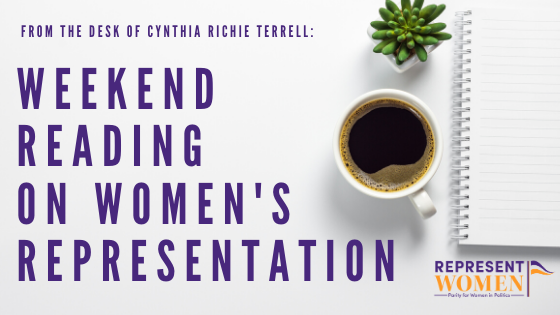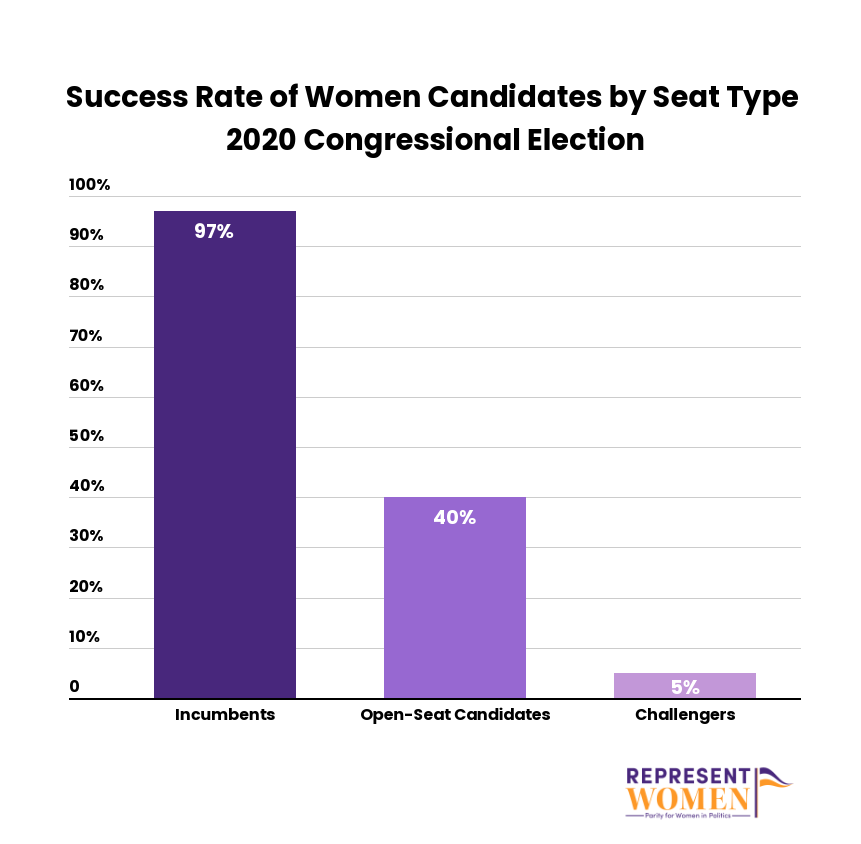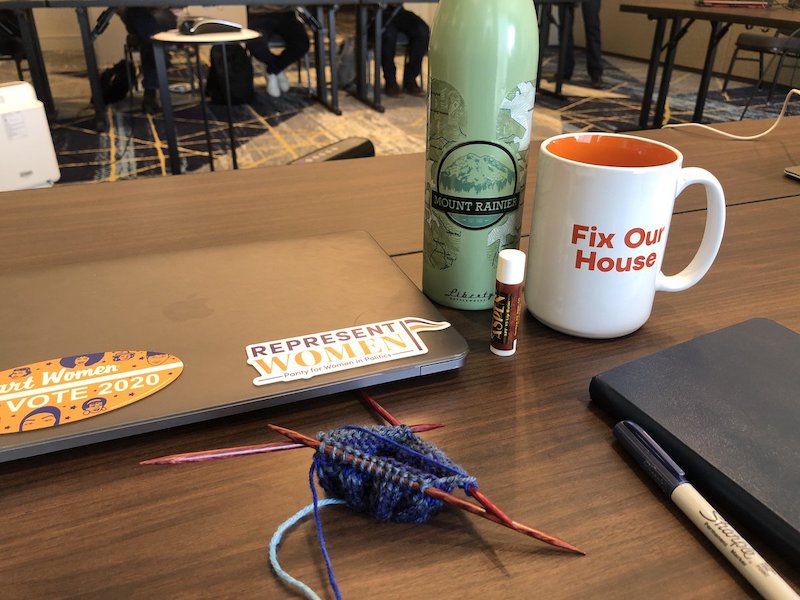
Weekend Reading on Women’s Representation is a compilation of stories about women’s representation in politics, on boards, in sports and entertainment, in judicial offices and in the private sector in the U.S. and around the world—with a little gardening and goodwill mixed in for refreshment!

I am back in the Bay Area this week meeting with other supporters of proportional voting to discuss strategies to modernize U.S. House elections with ranked-choice voting in districts that elect three or more people. This systems change—which The New York Times editorial page supports—would simultaneously eliminate gerrymandering, ensure partisan fairness, elect multiple communities of color from the Atlantic to the Pacific, and increase women’s representation in the House by at least 40 percent in the first few election cycles after adoption.
RepresentWomen is glad to convene a women’s thought leader table, in partnership with FairVote, to build support for proportional voting among women leaders.
The team pitched in again this week to share stories about outcomes for women in recent elections and policies that impact women’s political representation.
RepresentWomen’s digital media manager, Kaycie Goral, writes about this week’s primary in Oregon that yielded a first—three women vying for governor:
For the first time in the state’s history, three women candidates will run in Oregon’s 2022 governor race.
Oregonians will vote in a three-way race dominated by women candidates; former House Speaker Tina Kotek, former House Republican Leader Christine Drazan, and the well-funded unaffiliated candidate, long-time Democratic lawmaker Betsy Johnson.
Kotek, the longest-serving speaker of the Oregon House, won the Democratic nomination with 55%. Drazan, leading in a very crowded primary, won with just 24%, which, if it holds up, would be the lowest share of the Republican vote for a governor nominee in Oregon history going back at least 75 years.Only Two of Oregon’s 38 governors have been women: Barbara Roberts (1991-1995), and current governor Kate Brown, who took office in 2015.
According to the Center for American Women and Politics at Rutgers University, just 45 women have been governors of their states or territories. The record number of women serving simultaneously is nine.
Of the 45 women governors, 30 were first elected in their own right; three replaced their husbands, and 11 became governor by constitutional succession, six of whom subsequently won full terms.
Yes, Oregon’s primaries were a resounding win for women’s representation in the state and across the country—but what if we could expand that record by more than one woman elected every couple of years, or by waiting for a white male governor to step down for a woman to rise up in his place?
What if we stepped on the gas and made it easier for multiple women to run and win governor races? What if we established better norms for women to rise up through the ranks and take on leadership positions? What if we pushed our state’s officers to appoint gender balanced staff and cabinets?
See, that is the goal here. We take the win. Yes, but we must also continue to fight for better systems so more women can win more often.

Goral also writes about the primary in Georgia and the antiquated single-winner redistricting process that is causing a woman to lose a seat in Congress:
A Democratic primary in Atlanta’s suburbs shows how partisan gerrymandering cannibalizes fresh political talent, especially for women in politics.
It’s hard enough to run in an electoral system built to deter, but losing your seat after winning is politically devastating.
In this deep dive article from the 19th’s Amanda Becker, we go down to Georgia’s example.In the Gwinnett County primary, both candidates flipped their current districts in the blue waves; now, they’re competing to be the Democratic nominee in a recently redrawn Georgia 7th district that’s one-seat shy.
The candidates were both rising stars in the party, having flipped their districts in recent elections; Rep. Carolyn Bourdeaux did so in Georgia’s 7th District in 2020 and Rep. Lucy McBath in the 6th District in 2018.
However, after Republican redistricting, Covid impeding the U.S. census in 2020, and a couple of court challenges, Georgia has a total of zero competitive districts and a C rating from the Princeton Gerrymandering Project.
“It wasn’t too long ago that Bourdeaux referred to McBath as her ‘sister’ representing Georgia in the House, and the two women have remained largely civil in official campaign communications. But tension over McBath’s decision to run in the District was evident during a primary debate earlier this month.”
This partisan redistricting has scrambled Georgia’s House districts and pit two rising star women in the Democratic party against each other. In the end, Georgia will come out of this election short of at least one woman leader and made less representative, less democratic for it.
It might not be the devil, but partisan redistricting has certainly arrived in Georgia and it’s fiddling away with representative politics.

RepresentWomen research associate Steph Scaglia reflects on a story about a decision to expand the number of seats in the Welsh Senedd, which is an extremely effective vehicle for increasing women’s representation. The Academy of Arts and Sciences included a similar proposal among their recommendations in its stellar Our Common Purpose report:
This week in Welsh politics plans were revealed to increase the number of Senedd seats by nearly half and implement gender quotas. These reforms will likely be implemented before the 2026 election and seats will be allocated based on the D’Hondt proportional representation formula. A need for a more representative, diverse, and fairer Senedd motivated this reform.
In the US, similar efforts are underway. When the House of Representatives was established the representation ratio was 1 to 60,000. Today, the ratio is 1 to 747,000. Increasing the number of House seats would in turn increase women’s representation. Women and people of color are much more likely to win open-seats due to gender bias and protections typically enjoyed by incumbents.
The 2020 Congressional elections showed this effect: 93% of women incumbents lost their race, 5% of women challengers won their race, and 40% of women running for open-seats won their race.

The Fair Representation Act would fundamentally change the U.S. House structure through proposing the adoption of ranked-choice voting, multi-winner districts, and an independent redistricting commission. These three key reforms would increase partisan fairness, decrease political polarization, and increase Congressional racial and gender diversity.
Ultimately, the proposed Senedd reforms show that structural change is not just needed, but possible across democracies. Seat type is a primary determinant of success for women running for office, and changes must be made to increase women’s representation within Congress. Coupling U.S. House expansion with the passage of the Fair Representation Act would lead to a jump in racial and gender diversity within the House.

Katie Usalis, director of program and partnerships at RepresentWomen, writes about a ruling this week in California that is a setback for women’s representation on corporate boards:
California has always been seen as a leader in embracing reforms and upgrading old systems, including a law requiring women on corporate boards that was passed in 2018. This law came about largely due to the great efforts by the California Partners Project and its co-founders Jennifer Siebel Newsome and Olivia Morgan.
In its only three years of implementation, this law has contributed to huge progress towards gender balance in corporate boardrooms: women’s representation on corporate boards has doubled since 2018, and 2021 saw more women than men named to California boards. Washington state, Massachusetts, New Jersey, and Hawaii have all proposed similar bills. This is further evidence that structural, systemic reform is the most impactful way to achieve gender balance in our lifetimes.
After being challenged by a conservative legal group called Judicial Watch, we were surprised to find out this week that a Los Angeles judge has ruled this law unconstitutional, claiming it violates the right to equal treatment. Nathan Solis of the Los Angeles Times reports,
“Senate President Pro Tem Toni Atkins (D-San Diego), co-author of the bill, called the ruling disappointing.
“More women on corporate boards means better decisions and businesses that outperform the competition — that’s a studied, proven fact,” Atkins said in a statement. “We believe this law remains important — despite the disheartening ruling from the Los Angeles Superior Court — and it exemplifies equal access and opportunity, the very bedrock of our democracy. For those still afraid of women in positions of leadership, they need to work on figuring that out because the world is moving on without them.”
Former state Sen. Hannah-Beth Jackson, who testified during the trial and was also an SB 826 co-author, said the court’s ruling did not come as a surprise because Duffy-Lewis appeared skeptical of the law’s intention during the trial.
“She rejected what I think are the critical elements and hence ruled against us,” Jackson said by phone Monday. “I look forward to the case going forward to the higher courts and having the appellate courts reinstate the law.”
The court’s ruling is now under review in the secretary of state’s office.
Across the hall…it can be done pic.twitter.com/93SB7DXBmo
— Erin Koegel (@ErinKoegel) April 26, 2022
RepresentWomen research associate Paige Chan shared an article about Minnesota state Representative Erin Koegel, whose experience as a legislator with a small child speaks to the barriers many women elected officials face:
The history of American politics is male-dominated, creating a “boys club” environment that makes it difficult for women to break into politics. According to the Center for American Women and Politics, women compose only 31% of all state legislature seats in 2022. Yet, being elected is just the first barrier for women in politics. Serving as a woman politician within a structure not designed for women in mind means that women often suffer disproportionate hardships in office.
Minnesota State Senator Julia Coleman is one of those women. The Minnesota State Senate has a rule prohibiting visitors on the floor during session – even a Senator’s child. As a result, when State Senator Coleman brings her two year old to work, she must leave him in another room and check on him between sessions. Coleman and others state this is just one of the many deterrents that prevent women from running, for fear that they cannot balance motherhood and their job. Men rarely, if ever, have that concern.
When Erin Maye Quade sought the Minnesota DFL Party state Senate endorsement, she had the misfortune that the day of the convention was the same day as she was expected to go into labor. Ultimately, she went into labor and needed to go to the hospital, and the party decided to essentially disqualify her from the running rather than stop the proceedings.
Without structural reform, women will continue to be deterred from politics. It is on the onus of the parties to implement changes that will accommodate the realities of women’s lives. The desire to have a family should not disqualify someone from serving in office, but unfortunately that is the choice that the overwhelming majority of women and little to no men face.
RepresentWomen research associate Grace Beyer shared her thoughts about women’s leadership during times of conflict:
One common criticism of the idea of more women in leadership is that women lack the ability to lead capably during wartime. Women are often seen as dovish and incapable of both identifying or dealing with a threat. This idea falls flat in the face of reality.
Estonia, under the leadership of woman prime minister Kaja Kallas, has given more aid (as a measure of GDP) to Ukraine for their fight than any other nation on earth. Her steadfast and longtime support for ensuring Estonia’s defense, as well as her longtime willingness to not mince words, stating for years before the current conflict that “Russia’s imperialistic dream has never died,” have earned her the nickname of “Europe’s new Iron Lady.”
The small Baltic country is no exception. Just this week Sweden and Finland, two countries led by women prime ministers, both applied to NATO. In the midst of a war of aggression on a neighbor, both countries have decided to get more, not less, involved in ramping up their own defense and the defense of their neighbors. Both countries prided themselves on their neutrality, but faced with new information about the threat posed to their sovereignty these leaders decided that “the way things have always been done” isn’t necessarily “the way they should keep being done.” Perhaps that’s something we can learn from them.

If you are in the Washington, D.C., area, I highly encourage you to see John Proctor Is the Villain which is playing at the Studio Theater that is a searing inquiry into the victims and villains of the ongoing reality of sexual assault.
Things are unsettled at Helen County High in rural Georgia—rumors are swirling around a student’s dad, another student blew up her life and left for Atlanta, and Mr. Smith’s junior English class has to make it through sex ed before they can finally start The Crucible. But what one man calls a witch hunt, a young woman calls the truth, and when the teens start questioning what really happened in Salem, everything threatens to change. A new play from a major new voice, John Proctor is the Villain captures a generation in mid-transformation, running on pop music, optimism, and fury—writing their own coming of age story.
Remember to check out this week’s #AAPI must reads from the team at RepresentWomen:


As I write, I am sitting in sunny California amongst an incredible group of people talking about democracy and proportional voting with my knitting in my #MomentOfLift bag, my Fix Our House mug, and importantly, my Aspen chapstick.
That’s all for this week,
Cynthia
Sign and share Ms.’s relaunched “We Have Had Abortions” petition—whether you yourself have had an abortion, or simply stand in solidarity with those who have—to let the Supreme Court, Congress and the White House know: We will not give up the right to safe, legal, accessible abortion.
Up next:





